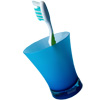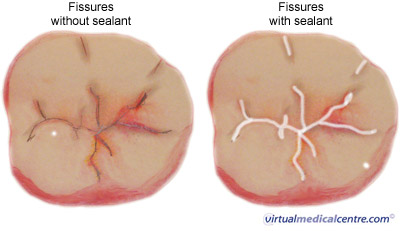- What are fissure sealants?
- The history of fissure sealants
- Why are sealants used?
- Types of fissure sealants
- How much do fissure sealants get used?
- How effective are fissure sealants?
- When should sealants be used?
- Procedure for placing sealants
- Maintenance of fissure sealants
- Complications of fissure sealants
What are fissure sealants?

Pits and fissures on the surface of the tooth are ideal in harbouring dental plaque and calculus, which contain bacteria. This area of plaque and calculus is often very difficult to clean, as the bristles on your toothbrush are often not able to get to the deepest part of these grooves. If the groves are not cleaned properly, decay will start on the top of the tooth, and the tooth will sometimes need a filling.
Fluoride, in your toothpaste and in your water, is very effective in protecting against decay; however its effect is minimal on the biting surface of teeth. Much of the decay encountered by school-aged children occurs in these pits and fissures, thus it is important to have a preventive agent to protect against decay. An American survey showed that up to 84% of the decay encountered in school-aged children is in these pits and fissures.
The history of fissure sealants
These materials and techniques have been used to close fissures in the past:
- Silver nitrate has been used to try and form a chemical reaction in the surface of the tooth, and consequently close the pit and fissure;
- Amalgam fillings have been used as a preventive approach to protect against further decay in the future however this is very destructive, and weakens your tooth. The chance of gaining more decay under amalgam compared to sealing with newer materials is also slightly higher;
- Several materials for sealing fissures have been tried, including:
- black copper cement, which is not used today
- cyanoacrylate (toxic),
- polyurethane,
- glass-ionomer cement (used today), and
- composite resin, which is like a plastic (primarily used today).
Why are sealants used?
Pit and fissure sealants were designed specifically for three preventive effects:
- Sealants occupy the pits and fissures of teeth with a resin material;
- As the pits and fissures are filled up, bacteria are not able to go deep into grooves, and this causes less “bad’ bacteria to be present on the tooth; teeth with fissure sealants are 22 times less likely to develop decay than those that have not been filled; and
- Sealants render the pits and fissures easier to clean during brushing and chewing, as food particles do not get trapped as easily when you have deep fissures.
Information on re-publishing of our images
Note that the picture on the left has clearly visible pits and grooves on the surface of the tooth. The picture on the right depicts a white sealant that has been placed to fill in the grooves.
Types of fissure sealants
The choice is one of personal preference. However, it has been demonstrated that coloured sealants (those that are very white or even pink) are more obvious to the person who has the sealant and dentist examining the sealant. The more obvious fissure sealants are, the easier it is to see whether they need replacement.
The amount of the time the sealant usually lasts depends on how well the contamination (from saliva, blood, and water) is controlled by the dentist during the procedure. Sometimes a rubber dam, or several pieces of cotton wool will be required to dry the area completely.
Glass ionomer cements, which are slightly different to the plastic sealants, usually do not last as long. They are useful for those children who are at high risk of dental decay, or when it is technically demanding to place the sealant; e.g. teeth that are still mostly in the gums or those children showing poor cooperation at the dentist.
How much do fissure sealants get used?
It is clear that sealants are safe, effective and underused. Approximately 20% of children aged 5-17 have fissure sealants on their baby or adult teeth. It is often said by dentists and reseachers that if the amount of fissure sealants was higher, the amount of decay would be lower.
To date, there is a lack of acceptance by dentists due to concerns over how long sealants last, fear of sealing over decay and causing further decay, and cost-effectiveness to the individual.
How effective are fissure sealants?

If sealants are lost, it is most likely a result of technical error in the sealant’s application rather than the result of poor bond strength. If applied properly, the bond between sealant and tooth is unlikely to fail. Most sealants that fail occur in the first 6 months, and this most likely comes down to the fact there was contamination during the placement of the fissure sealant.
Decay is at times very hard to diagnose on a person’s tooth, thus some dentists are worried that placing a sealant over decay will cause further decay in the future. Even if a small amount of decay is covered by the dentist accidentally, these areas of decay do not progress rapidly, if at all. Some dentists even intentionally leave a small amount of decay in place, to avoid further damage of the tooth, and this is also acceptable.
From a cost-effectiveness point of view, it has been concluded that sealants are justified in a person who is at risk of decay in their mouth, that is, those individuals with 2 or more decayed, missing, or filled teeth due to decay. Conversely, if a person was not at a high risk, it was recommended to avoid placing sealants from a cost point of view.
The total average time to place sealants is around 10 minutes, while the average time to place a similar amalgam filling (silver filling) is about 14 minutes.
Sealants can therefore be concluded:
- To be effective in preventing decay;
- To have a reasonably long term retention in the mouth;
- To stop decay that has been covered by the dentist; and
- To be better to amalgam in terms of time requirements, and tooth destruction.

When should sealants be used?
Below is a generalised overview of whether a dental professional should use a fissure sealant.
| Criteria | Seal | Do not seal |
|---|---|---|
| Tooth age | A tooth that has just come through into the mouth. | Teeth that have remained free of decay for 4 years or longer. |
| Tooth type | Molars (which are the teeth at the back of your mouth) | Front teeth (very rarely is there a need to seal front teeth) |
| Depth of pits and fissures | Deep, retentive, narrow pits and fissures, which are excellent at attracting plaque | Wide, unretentive, shallow grooves that are easily cleaned by the person |
| The risk of decay | Teeth that are soft, or in a person who has had decay in two or more teeth | Teeth that have remained free of decay for 4 years or longer |
| Availability of other preventive measures | Person is having fluoride in their diet and still has decay | Person is not following dentist’s advice, and is continually getting more decay; this will require a filling rather than a sealant |
Procedure for placing sealants
Fissure sealant application is a relatively straightforward procedure that can be completed by a dentist, dental therapist, or dental hygienist.
The general procedure is:
- Teeth are thoroughly cleaned and dried, as food debris and saliva can prevent the sealant from sticking correctly to the tooth.
- The tooth surface is coated with a weak acid gel or chemical solution, to ensure that the sealant bonds to the tooth.
- An adhesive is applied under the sealant.
- The sealant is applied.
- Depending on the type of sealant, a strong light may be used to activate bonding and hardening of the material.
- The liquid sealant forms a durable material on the tooth surface.
- The bite is checked, and excess material is polished off.
Maintenance of fissure sealants

Sealed teeth generally do not require any changes at home, or dietary changes. Although fissure sealants help with decay prevention on molar teeth especially, it is important to regularly brush and floss teeth and avoid the factors that can lead to tooth decay.
Complications of fissure sealants
Very uncommonly, fissure sealants may cause complications such as:
- Minor gum or tooth discomfort due to the scaling or pre-coating process;
- Hypersensitivity to sealant chemicals; and/or
- An uncomfortable change in the bite due to the thickness of the sealant.
Kindly written by:
Dr Akhil Chandra BDSc. (Hons UWA)
Dentist, Whitfords Dental Centre andEditorial Advisory Board Member of the Virtual Dental Centre
More information
 |
For more information on dental health in children, including teething, hygiene and nutrition for good teeth, as well as the importance of dental check-ups, see Dental Health in Children. |
References
- Cameron A, Widmar R. Handbook of Paediatric Dentistry. London: Mosby; 1997. [Book]
- Mitchell DA, Mitchell L. Oxford Handbook of Clinical Dentistry (4th edition). New York: Oxford University Press; 2005. [Book]
- Patient education pamhplets: Fissure sealants [brochure]. Australian Dental Association; 2009.
- Roberson TM, Heymann HO, Swift EJ Jr (eds). Studervant’s Art and Science of Operative Dentistry (4th edition). St Louis: McGraw-Hill; 2002. [Book]
- National Center of Health Statistics. Plan and operation of the Third National Health and Nutrition Examination Survey (NHANES III), 1988-1994 (PHS publication no. 94-1308). Vital Health Stat 1. 1994;(32):1-407. Available from: URL link
- Weintraub JA. The effectiveness of pit and fissure sealants. J Public Health Dent. 1989;49(5):317-30. [Abstract]
- Dental Product Spotlight: Pit and fissure sealants. J Am Dent Assoc. 2002;133(9):1275. [Full text]
- Therapeutic Guidelines: Oral and Dental (1st edition). North Melbourne: Therapeutic Guidelines Limited; 2007. [Book]
- Simonsen RJ. Cost effectiveness of pit and fissure sealant at 10 years. Quintessence Int. 1989;20(2):75-82. [Abstract]
- Beauchamp J, Caufield PW, Crall JJ, et al. Evidence-based clinical recommendations for the use of pit-and-fissure sealants: A report of the American Dental Association Council on Scientific Affairs. Dent Clin North Am. 2009;53(1):131-47. [Abstract]
- Ripa LW. Occlusal sealants: Rationale and review of clinical trials. Int Dent J. 1980;30(2):127-39. [Abstract]
- Straffon LH, Dennison JB. Clinical evaluation comparing sealant and amalgam after 7 years: Final report. J Am Dent Assoc. 1988;117(6):751-5. [Abstract]
- Going RE, Loesche WJ, Grainger DA, Syed SA. The viability of microorganisms in carious lesions five years after covering with a fissure sealant. J Am Dent Assoc. 1978;97(3):455-62. [Abstract]
- Handleman SL, Buonocore MG, Schoute PC. Progress report on the effect of a fissure sealant on bacteria in dental caries. J Am Dent Assoc. 1973;87(6):1189-91. [Abstract]
- Leverett DH, Handelman SL, Brenner CM, Iker HP. Use of sealants in the prevention and early treatment of carious lesions: Cost analysis. J Am Dent Assoc. 1983;106(1):39-42. [Abstract]
- Azarpazhooh A, Main PA. Pit and fissure sealants in the prevention of dental caries in children and adolescents: A systematic review. J Can Dent Assoc. 2008;74(2):171-7. [Abstract | Full text]
This treatment is used for the following diseases
All content and media on the HealthEngine Blog is created and published online for informational purposes only. It is not intended to be a substitute for professional medical advice and should not be relied on as health or personal advice. Always seek the guidance of your doctor or other qualified health professional with any questions you may have regarding your health or a medical condition. Never disregard the advice of a medical professional, or delay in seeking it because of something you have read on this Website. If you think you may have a medical emergency, call your doctor, go to the nearest hospital emergency department, or call the emergency services immediately.








